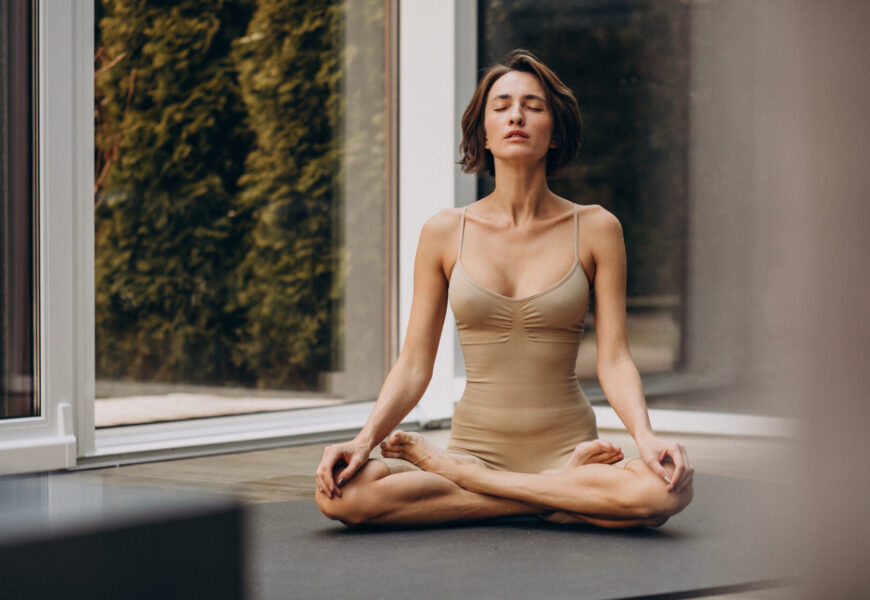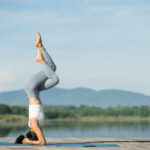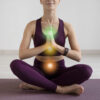Imagine a way to not only stretch your body but also soothe your mind and promote inner peace—a practice known as Yin Yoga offers just that.
In this comprehensive blog post, we’ll delve into the world of Yin Yoga, uncovering its essence and unraveling its secrets. Yin Yoga isn’t your typical yoga; it’s a slow and contemplative style that targets deep connective tissues in your body.
We’ll explore its history, principles, and how it differs from other yoga forms, making it accessible to everyone, regardless of their experience level.
This guide aims to be your ultimate companion on your journey to understanding Yin Yoga, helping you harness its physical and mental benefits.
Whether you’re a curious beginner or a seasoned yogi, get ready to embark on a path that enhances flexibility, relieves stress, and fosters a profound mind-body connection, all through the gentle art of Yin Yoga.
What Is Yin Yoga?

Yin Yoga is a calming and reflective style of yoga that focuses on the quieter, slower side of the practice. In Yin Yoga, we take a gentle, patient approach, holding poses for a longer time – usually several minutes – as compared to more active styles of yoga.
What makes Yin Yoga unique is its emphasis on letting go, both physically and mentally. Instead of striving for intense stretching or building muscle strength, we encourage a sense of surrender and relaxation in the poses.
This practice is like a gentle, soothing balm for our body and mind. It’s a bit like soaking in a warm, fragrant bath for your muscles and connective tissues.
Yin Yoga complements the more dynamic and energetic styles of yoga and can be a wonderful way to unwind, increase flexibility, and dive into the depths of your own thoughts and sensations.
So, if you’re looking to slow down, find stillness, and nourish your inner self, Yin Yoga might just be your ticket to a more relaxed and balanced life.
History Of Yin Yoga
Yin Yoga has its roots in ancient traditions, kind of like the way our grandparents passed down stories through generations. It draws inspiration from Daoist and Buddhist teachings that have been around for centuries.
These teachings emphasize balance, harmony, and the idea that opposites like light and dark, or yin and yang, are interconnected.
In the world of yoga, two key figures played significant roles in shaping Yin Yoga as we know it today: Paulie Zink and Paul Grilley. They took these ancient ideas and breathed new life into them.
You could say they were like modern-day storytellers, taking the old tales and retelling them for a new audience.
Paulie Zink, a martial artist, brought the concept of Yin Yang yoga in the 1970s. He combined the slow, passive postures of Daoist yoga with the more dynamic and active poses of martial arts, creating a unique blend.
Then came Paul Grilley, who studied with Paulie Zink and expanded on his ideas. Grilley’s teachings emphasized the importance of long, deep stretches held for several minutes to target not just muscles but also the connective tissues in our bodies, like ligaments and fascia.
As Yin Yoga made its way to the Western world, it continued to evolve. Teachers and practitioners added their own twists to the practice, making it accessible to people from all walks of life.
Today, Yin Yoga is practiced and loved by many, offering a gentle yet profound way to connect with our bodies and minds.
It’s a bit like a timeless tale that keeps getting passed down, with each generation adding its own chapter to the story.
And just like any good story, Yin Yoga continues to inspire and captivate those who embark on its journey.
Key Principles Of Yin Yoga

Principle Of Yin And Yang
In Yin Yoga, we embrace the concept of balance and harmony found in the ancient philosophy of Yin and Yang.
This principle is all about finding equilibrium between opposites. In life, we encounter contrasting forces, like day and night, hot and cold, or tension and release. In Yin Yoga, we seek to balance these opposing qualities.
The “Yin” qualities are passive, slow, and receptive, while the “Yang” qualities are active, dynamic, and strong.
By understanding and harmonizing these qualities in our practice, we can find a sense of balance in our bodies and minds.
Principle Of Long, Passive Holds
Yin Yoga is distinctive for its extended, gentle poses. We hold these poses for a relatively long time, typically 3-5 minutes or even longer.
This extended duration allows us to reach into the deeper layers of our body, targeting the connective tissues like fascia, ligaments, and tendons. It’s not about pushing ourselves to the limit; instead, we aim for a comfortable discomfort.
By staying still in these poses and not forcing our bodies, we encourage a gradual release of tension and an increased range of motion.
Principle Of Stillness And Awareness
The heart of Yin Yoga lies in stillness and mindfulness. We cultivate mindfulness by paying close attention to our breath, sensations, and thoughts during the practice.
This process of being fully present in the moment helps us develop self-awareness and a deeper connection to our bodies.
Embracing silence is another crucial aspect. In our fast-paced lives, silence can be a rare gift. Yin Yoga provides a space to embrace this quietude.
As we hold poses and let go of external distractions, we can tune into our inner world, observing the sensations and thoughts that arise without judgment.
This practice of stillness and awareness not only benefits our physical bodies but also nourishes our mental and emotional well-being.
Key Differences From Other Yoga Styles
Yin Yoga stands apart from many other yoga styles because it focuses on holding poses for longer periods, typically 3 to 5 minutes or even longer.
Unlike more dynamic yoga styles that emphasize movement and muscular engagement, Yin Yoga encourages you to relax into postures, targeting the deep connective tissues and fascia in your body.
It’s like giving your muscles a break and diving into a deeper, more meditative practice. While other yoga forms might aim for flexibility and strength, Yin Yoga is all about enhancing your flexibility and mobility by gently stretching these often-neglected tissues.
How To Get Started For Yin Yoga Practice

Setting Up Your Space
Before starting your Yin Yoga practice, find a quiet and comfortable space where you won’t be disturbed. Lay down a soft yoga mat or a folded blanket. Ensure the room is dimly lit to create a calming atmosphere.
You might want to have a cushion or yoga block nearby for support during certain poses. Creating a serene space helps you relax and fully immerse in your practice.
Breathing Techniques
In Yin Yoga, we focus on gentle, deep breathing. Breathe slowly and deeply through your nose, allowing your belly to rise with each inhale and fall with each exhale.
This kind of breath helps calm your mind and encourages your body to relax further into each pose. Remember, it’s not about forceful or rapid breathing; it’s about finding a natural, peaceful rhythm.
Holding Poses And Duration
Yin Yoga is all about holding poses for a longer time, typically 3 to 5 minutes or even more. The idea is to relax your muscles as much as possible and let gravity and time do the work.
Initially, you might feel some discomfort, but it should never be painful. Focus on finding your edge – the point where you feel a gentle stretch but can still breathe deeply and relax.
Incorporating Meditation And Mindfulness
Yin Yoga is not just about physical postures; it’s also a practice of the mind. While holding poses, bring your attention to your breath and the sensations in your body.
This mindful awareness helps you let go of stress and worries, promoting inner peace and relaxation. You can also incorporate meditation techniques like observing your thoughts or using a mantra to enhance your practice.
Warm-Up And Cool-Down
Unlike more dynamic yoga styles, Yin Yoga doesn’t require an extensive warm-up. You can start with a few gentle stretches to prepare your body, but the real warmth and opening happen during the practice itself.
After your Yin session, it’s a good idea to close with a short relaxation pose like Savasana (corpse pose) to integrate the benefits of your practice.
Key Yin Yoga Poses
Yin Yoga has a unique set of poses, also known as asanas. These poses are different from the ones you might find in other forms of yoga.
They are usually done while sitting or lying down, and they involve relaxing and holding the positions for a longer time, often several minutes.
Yin Yoga poses are all about letting go of tension and allowing your body to sink into them slowly. They may seem simple, but they work deeply on your muscles, fascia, and connective tissues.
Butterfly Pose

- Sit down with your spine straight.
- Bend both knees and bring the soles of your feet together in front of you.
- Let your knees drop outward, allowing them to descend naturally toward the floor.
- Hold your feet with your hands, interlacing your fingers around your toes.
- Maintain a straight back and gently hinge at your hips.
- As you fold forward, avoid rounding your back excessively; aim to reach your chest toward your feet.
- Feel a stretch in your inner thighs and groins.
- Breathe deeply and hold the pose for 3-5 minutes.
Benefits:
- Relieves tension in the inner thighs and groins.
- Encourages a deep release in the hip area.
- Promotes greater flexibility in the hips.
Dragon Pose
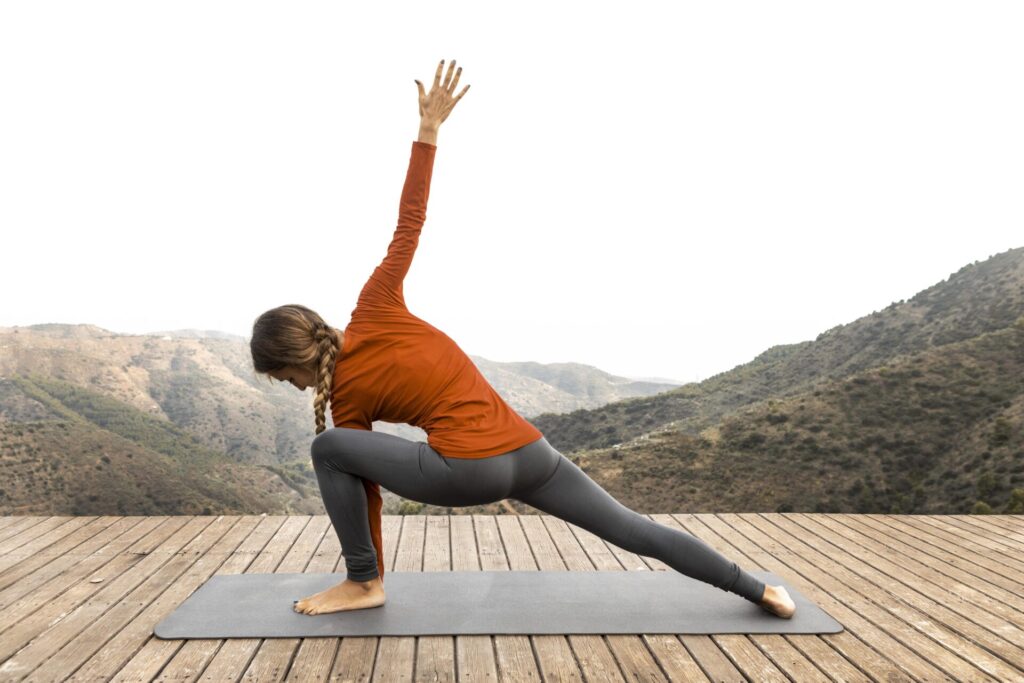
- Begin in a lunge position with one foot forward and the knee bent at a 90-degree angle, aligning it with your ankle.
- Extend the other leg behind you, keeping it straight.
- Place both hands on the inside of your front foot.
- Sink your hips down and forward, feeling a stretch in your hip flexors and groin.
- You can use props like blocks under your hands if needed.
- Hold the pose for 3-5 minutes on each side.
- Maintain deep, slow breaths throughout.
Benefits:
- Releases tightness in the thighs and groin.
- Helps alleviate hip discomfort.
- Enhances hip flexibility and mobility.
Sphinx Pose
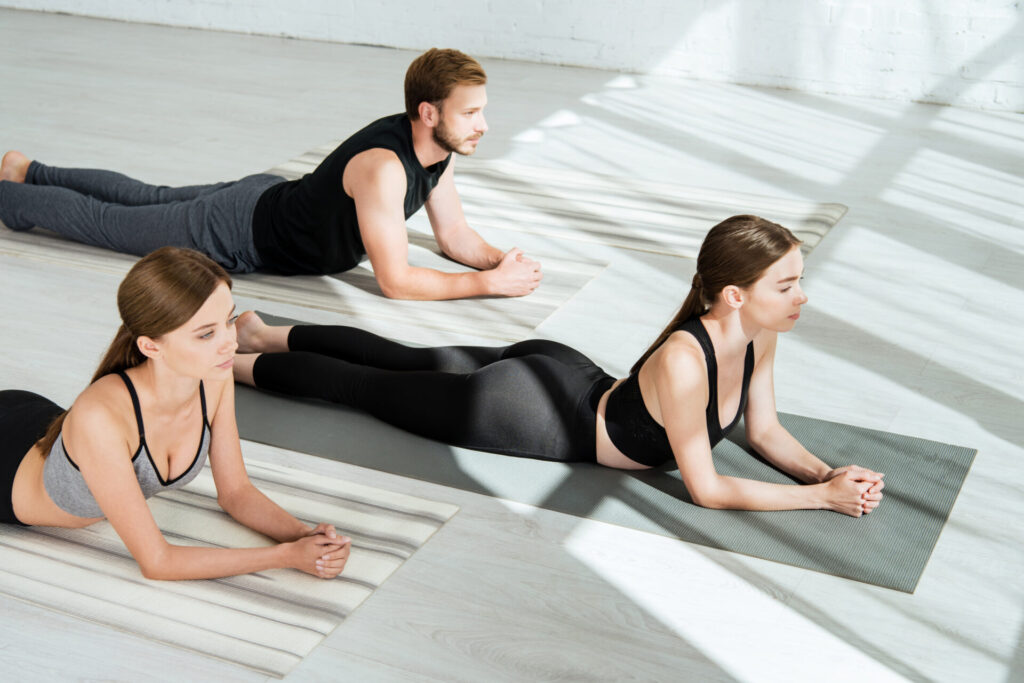
- Lie on your belly with your legs extended straight.
- Place your elbows under your shoulders, forming a 90-degree angle with your forearms on the mat.
- Keep your palms facing down.
- Press your forearms into the mat, lifting your chest and head while keeping your pelvis grounded.
- Gently draw your shoulders away from your ears.
- Allow your lower back to relax and arch slightly.
- Focus on opening your heart center.
- Hold the pose for 2-4 minutes.
Benefits:
- Strengthens and stretches the lower back.
- Supports spine health.
- Encourages better posture.
Caterpillar Pose

- Sit with your legs extended straight in front of you.
- Flex your feet to activate your leg muscles.
- Inhale, lengthen your spine, and as you exhale, hinge at your hips.
- Reach forward with your hands, keeping your back straight.
- Only go as far as your flexibility allows; it’s okay if you can’t touch your toes.
- Hold the position for 3-5 minutes.
- Continue to breathe deeply and relax into the stretch.
- Feel the stretch along your spine, hamstrings, and calves.
Benefits:
- Eases tension in the lower back and hamstrings.
- Aids in relaxation and stress reduction.
- Improves flexibility in the legs and spine.
Shoelace Pose
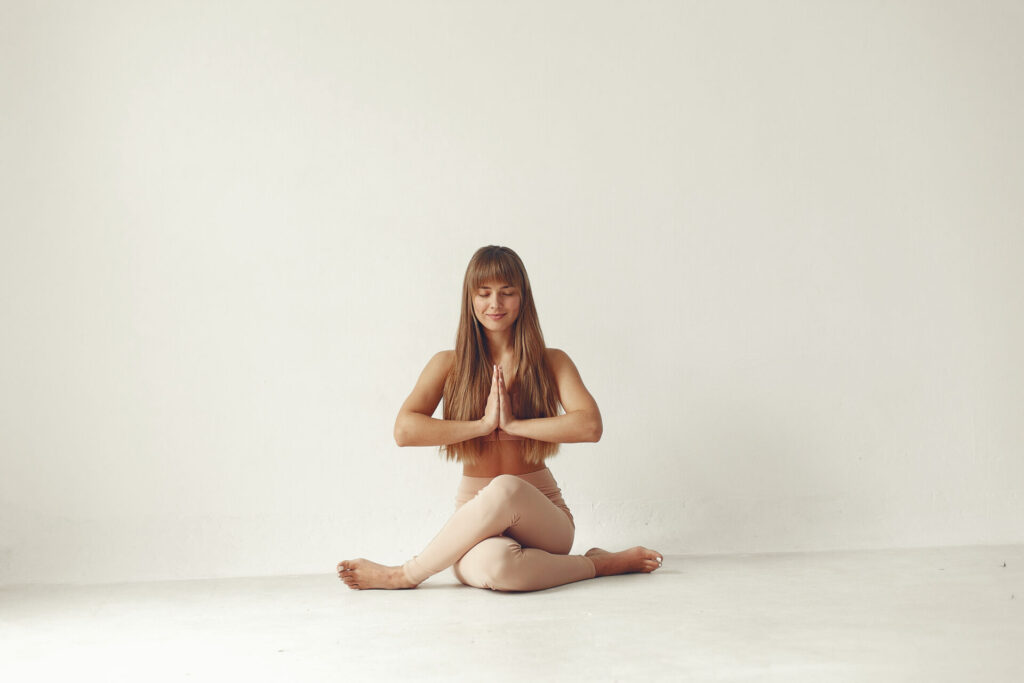
- Start in a seated position with your legs extended.
- Bend both knees and stack one knee on top of the other, like crossing your legs.
- Attempt to align your knees as closely as possible.
- Flex your feet to protect your ankles.
- Sit up tall and engage your core.
- You can gently lean forward at your hips to deepen the stretch.
- Feel the sensation in your outer hips and lower back.
- Hold for 3-5 minutes on each side.
- Keep your breathing steady and relax into the pose.
Benefits:
- Increases hip mobility and flexibility.
- Helps alleviate discomfort in the lower back.
- Encourages balance and alignment in the hips.
Modifications And Props

Don’t worry if you can’t do these poses perfectly at first. Yin Yoga is all about finding your edge and being comfortable in your own body.
You can use props like pillows, blocks, or blankets to support you and make the poses more accessible.
Remember, it’s not about how far you can stretch but about finding a gentle, sustainable stretch that works for you. So, take your time and explore these poses at your own pace.
Benefits of yin yoga
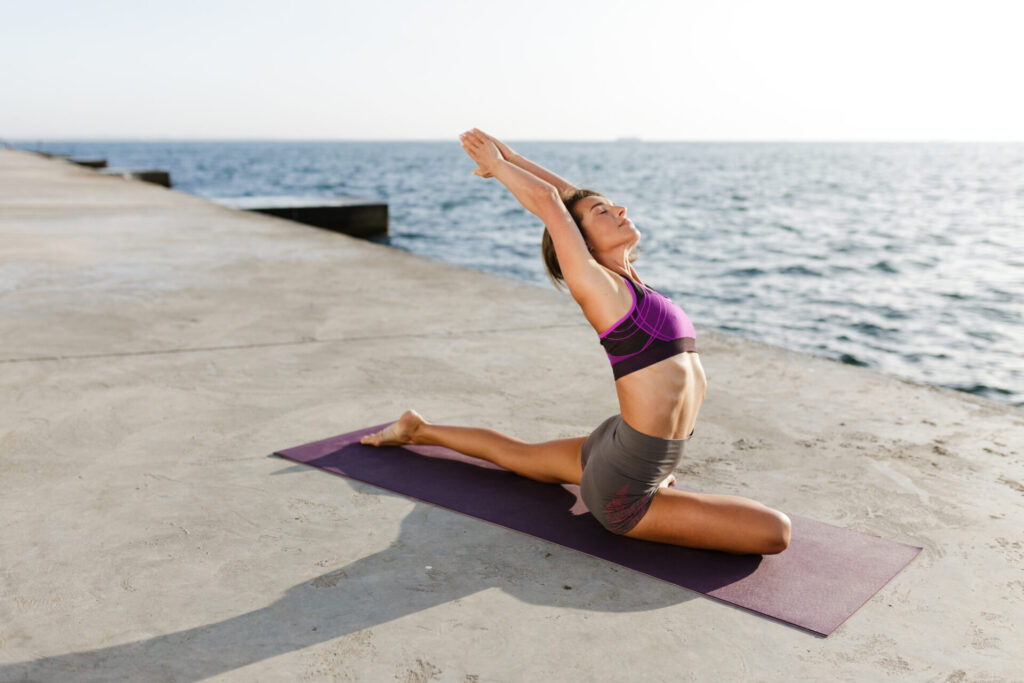
Improved Flexibility And Joint Health
Yin Yoga helps make your body more bendy and keeps your joints happy. When you hold poses for a while, it stretches your muscles and the connective tissues around your joints. Over time, this can make you feel more limber and reduce the risk of joint stiffness.
Stress Reduction And Relaxation
Yin Yoga is like a mental spa day. It encourages deep relaxation and calms your busy mind. The slow, steady stretches help your body release tension, and the focus on your breath can lower stress hormones. This can lead to a greater sense of inner peace and relaxation.
Emotional Release
Sometimes, we store emotions in our bodies, like worry in our shoulders or sadness in our hips. Yin Yoga can gently release these emotions. As you hold poses, you might feel emotions bubbling up, and that’s okay. It’s a way to let go of what you’ve been holding onto and find emotional healing.
Improved Sleep
Yin Yoga can be a ticket to dreamland. By relaxing your body and mind, it can help improve the quality of your sleep. Better sleep means more energy during the day and a happier, more alert you.
Enhanced Mind-Body Connection
This is like strengthening the Wi-Fi signal between your brain and body. Yin Yoga makes you more aware of how your body feels. You’ll notice sensations and tensions you might have missed before. This can help you make better choices for your body’s well-being, both on and off the yoga mat.
Yin Yoga And Traditional Chinese Medicine
Yin Yoga might sound a bit mysterious, but it’s actually quite simple and wonderful for your body and mind.
It’s like the calming opposite of our busy and fast-paced lives. Imagine it as a peaceful break from all the hustle and bustle.
Yin Yoga connects deeply with the ancient wisdom of Traditional Chinese Medicine (TCM), which is all about keeping the body’s energy, known as “Qi” (pronounced “chee”), in balance.
Imagine Yin Yoga as a sort of harmonious dance with TCM principles. In TCM, there’s a concept of Yin and Yang, like day and night or hot and cold, and they need to be balanced for good health.
Yin Yoga is the yin to our fast-paced, yang-filled lives; it’s the quiet and calm that we often need. The practice also taps into our “meridians,” which are like energy highways in our bodies.
Each yin yoga pose can stimulate specific meridians, which can help release blockages and promote the flow of energy, aiding in physical and emotional wellness.
So, practicing Yin Yoga isn’t just about physical postures; it’s like giving your body’s energy system a soothing and revitalizing massage, bringing about balance and well-being.
Yin Yoga Tips And Precautions
When practicing Yin Yoga, it’s important to keep a few things in mind to make the most of your experience.
First, be patient with yourself. Yin Yoga requires you to hold poses for longer periods, and it’s normal to feel some discomfort. However, if you experience sharp pain, it’s a sign to back off or modify the pose.
Second, remember to stay relaxed and breathe deeply. This helps your body release tension and go deeper into the stretch. Using props like cushions or blocks can also make poses more accessible and comfortable.
Lastly, if you have any pre-existing medical conditions or injuries, it’s a good idea to consult with a healthcare professional or a certified Yin Yoga instructor before starting your practice. Safety always comes first.
How And Where To Find Yin Yoga Classes
When you’re ready to begin your Yin Yoga journey, finding the right classes can be quite exciting.
To discover Yin Yoga classes, First, check out local yoga studios or wellness centers near you; just do a quick online search using terms like “Yin yoga near me” or “Yin Yoga classes near me.”
Don’t hesitate to reach out to these studios to ask about their class schedules and teachers.
Nowadays, it’s super easy to take Yin Yoga classes online – big websites and subscription services offer classes taught by experienced instructors.
For more helpful resources, you can also visit the official Yin Yoga website at www.yinyoga.com. If you want a deeper dive into Yin Yoga, think about joining retreats or workshops; they can give you a better understanding of the practice and connect you with like-minded folks.
With these options, including the official Yin Yoga website, you’ve got plenty of choices to find Yin Yoga classes that work for you. Enjoy your journey!
Frequently Asked Questions (FAQs)
Wrapping Up
In conclusion, Yin Yoga offers a unique and rewarding way to improve your physical and mental well-being.
By embracing the principles of stillness, balance, and patience, you can unlock the many benefits this practice has to offer.
Whether you’re looking to enhance flexibility, reduce stress, or connect more deeply with your inner self, Yin Yoga provides a path to achieve these goals.
So, take your time, explore the poses, and remember that it’s not about perfection but about the journey toward a healthier and more balanced you.
Give Yin Yoga a try, and you may find that it becomes a valuable part of your daily life, helping you find tranquility and balance in our often hectic world.

